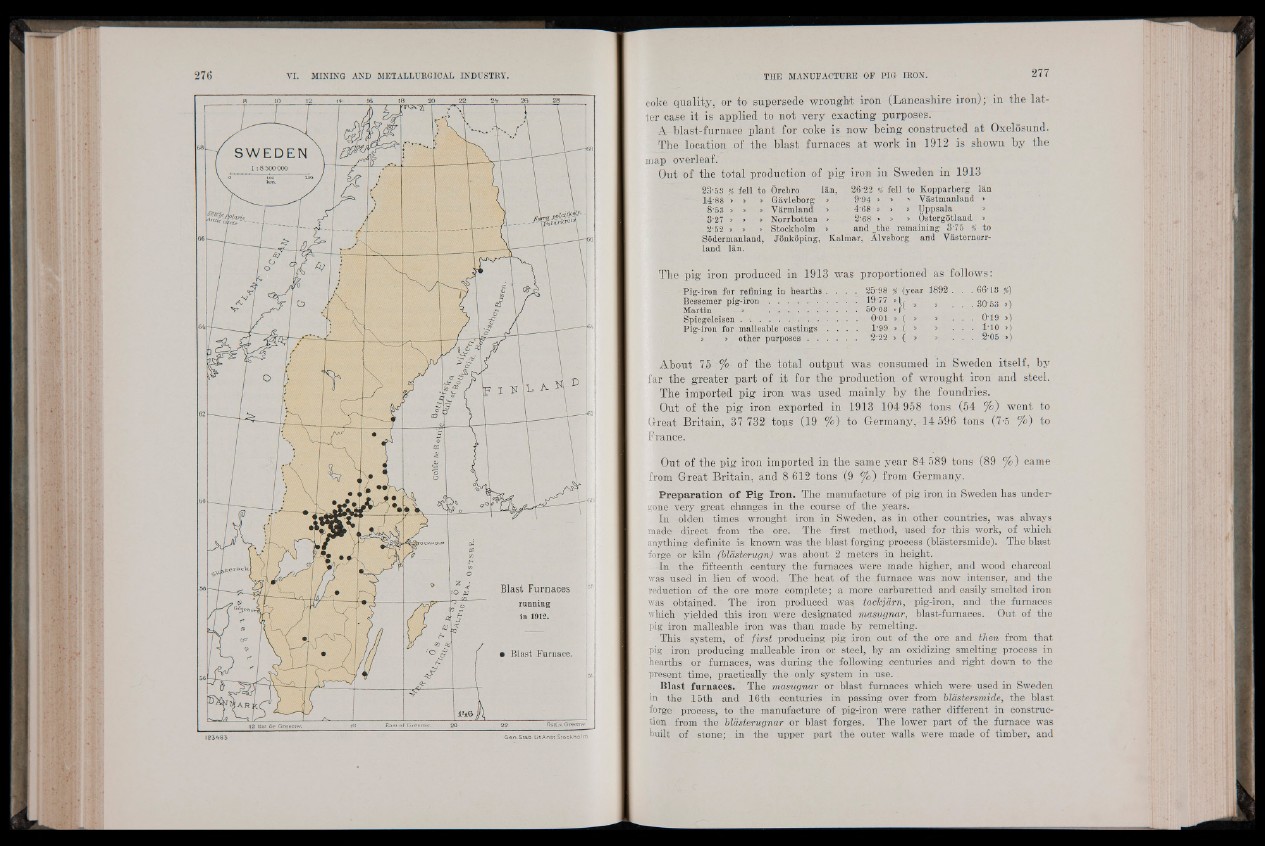
coke quality, or to supersede wrought iron (Lancashire iron); in the latter
case it is applied to not very exacting purposes.
A- blast-furnace plant for coke is now being constructed at Oxelosund.
The location of the blast furnaces at work in 1912 is shown by the
map overleaf.
Out of the total production of pig iron in Sweden in 1913
23-53 ja fell to Örebro lan, 26*22 % fell to Kopparberg lan
14*88 * » » Gavleborg > 9*94 > > ■> Vastmanland >
853 » * > Yarmland » 4*68 » » > Uppsala »
3-27 » » » Norrbotten » 2*68 > > » Ostergotland >
2‘52 > » » Stockholm » and the remaining 375 % to
S'odermanland, Jdnkoping, Kalmar, Alvsborg and Yasternorr-
land lan.
The pig iron produced in 1913 was proportioned as follows:
Pig-iron for refining in heartbs . . . . 25*98 % (year 1892 . . . 66* 13 %)
Bessemer p ig -iro n 19*77 »1, , gg.gg .
Martin ...»......... ................................... 50*03 »0
Spiegeleisen . 0*01 » ( » | . . . 0*19 »)
Pig-iron for .malleable castings . . . . 1-99 > ( > j . . . 1*10 »)
i > other purposes...................... 2*22 » ( > > . . . 2*06 »)
About 7.5 of the total output was consumed in Sweden itself, by
far the greater part of it for the production of wrought iron and steel.
The imported pig iron was used mainly by the foundries.
Out of the pig iron exported in 1913 104 958 tons (54 %) went to
Great Britain, 37 732 tops (19 %) to Germany, 14 596 tons (7*5 %) to
France.
Out of the pig iron imported in the same year 84 589 tons (89 %) came
from Great Britain, and 8 612 tons (9 %) from Germany.
P r ep a ra tion o f P ig Iron. The manufacture of pig iron in Sweden has undergone
very great changes in the course of the years.
In olden times wrought iron in Sweden, as in other countries, was always
made direct from the ore. The first method, used for this work, of which
anything definite is known was the blast forging process (blastersmide). The blast
forge: or kiln (bldsterugn) was about 2 meters in height.
In the fifteenth century the furnaces were made higher, and wood charcoal
was used in lieu of wood. The heat of the furnace was now intenser, and the
reduction of the ore more complete; a more earburetted and easily smelted iron
was obtained. The iron produced was tacTcjarn, pig-iron, and the furnaces
which yielded this iron were designated masugnar, blast-furnaces. Out of the
pig iron malleable iron was than made by remelting.
This system, of first producing pig iron out of the ore and then from that
pig iron producing malleable iron or steel, by an oxidizing smelting process in
hearths or furnaces, was during the following centuries and right down to the
present time, practically the only system in use.
Blast furnaces. The masugnar or blast furnaces which were* used in Sweden
in the 15th and 16th centuries in passing over from blastersmide, the blast
forge process, to the manufacture of pig-iron were rather different in construction
from the blasterugnar or blast forges. The lower part of the furnace was
built of stone; .in the upper part the outer walls were made of timber, and